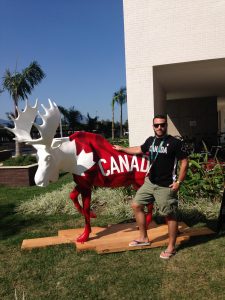Olympic athletes disproportionately white and privately educated compared to general population
May 11/2017
White and privately educated Olympic athletes, particularly Winter Olympic Games athletes, are over-represented on four high-income country Olympic teams, according to a University of Toronto public health researcher who conducted the first international study to examine sociodemographic profiles of individual athletes.
“Public funds are heavily subsidizing Olympic teams that are comprised of primarily of white and privately educated elite athletes, in Canada and in high income countries globally,” said Dr. David Lawrence, the study’s lead author and Master’s student in Epidemiology at the Dalla Lana School of Public Health.
Olympic sports and athletes receive significant financial support from the publicly funded federal budget, an investment that is intended to promote health and physical activity. The Canadian Federal Government provides approximately $197 million annually to Sport Canada, most of which is directed towards elite and Olympic athletes.
A former university rugby player and member of the Canadian Health Services Team last summer in Rio de Janeiro, Lawrence decided to pursue a public health degree after practicing for two years as a sports medicine physician so he could critically evaluate this so-called “trickle-down effect” of elite sport to increase physical activity at a population level.
“Not only is the evidence linking elite sports and population health weak, our study found significant access and equity issues that restrict individuals from a lower socioeconomic status, creating a participation parity barrier,” said Lawrence, who received his medical degree from U of T Medicine in 2013 and trained in sports medicine at St. Michael’s Hospital.
In the study, Sociodemographic Profile of an Olympic Team published today in Public Health, Lawrence and his team collected sociodemographic data from publically available resources for all athletes representing Canada, the United States of America, Great Britain, and Australia at the 2014 Sochi Winter Olympic Games and the 2016 Rio Summer Olympic Games.
The research team studied information of 568 winter and 1,643 summer athletes, including the Olympic committee database, sport organizations’ database, school-specific (i.e. University, College, or secondary school) database, personal biographies, media reports and social media profiles. Researchers subjectively classified each athlete as white or non-white based on their photo, determined their secondary school-type (private, public, or home schooled), and compared the prevalence of white, privately educated athletes with the prevalence in the general population.
Researchers found that the percentage of the elite athlete population that is white is much larger than the general population. Privately educated athletes constituted 30.3 per cent, and 32.7 per cent of winter and summer athletes, respectively and 94.9 per cent of winter, and 81.7 per cent of summer athletes were white.
From a Canadian perspective, the prevalence privately educated Canadian athletes were significantly higher than the general population prevalence for both the Canadian Winter and Summer Olympic teams. The prevalence of white Canadian athletes was significantly higher amongst the winter team, but not for the summer team.
Summer Olympic athletes demonstrated greater diversity in ethnicity and affluence. Athletics (track and field), basketball, gymnastics, taekwondo, table tennis and judo were sports found to exhibit the most ethnic and wealth diversity. However, certain sports, including equestrian, sailing, cycling, and rowing, consistently favoured white and privately educated athletes.
“I think that Canada and other countries that emphasize elite sport through the diversion of public resources should re-evaluate this practice,” said Lawrence. “We know funding elite sport does not provide societal benefit, so governments must invest in strategies to promote health in the general population, such as community runs, access to green space and community centres.”
